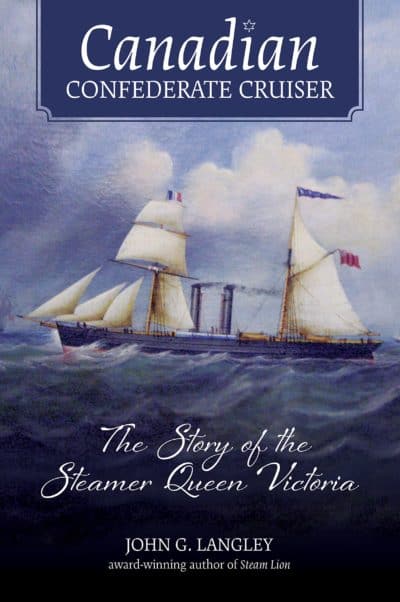The official year of Canadian confederation is 1867, but we need to turn back the calendar to the Charlottetown Conference in 1864 when representatives from Canada West and East came to the city of Charlottetown PEI to try to convince the Maritime delegates to favour confederation rather than a Maritime union which would not benefit the Canadians at all. The role of the steamer Queen Victoria in all this was pivotal, not only as a means of transportation but as a type of floating hotel with a hold packed full of Champagne and other amenities suitable to entertaining, persuading and befriending the East Coasters. [perfectpullquote align=”right” bordertop=”false” cite=”John G. Langley” link=”” color=”#0F155E” class=”” size=””]”This steamer – a relatively small ship – occupies a significant place on the mantel of Canadian Confederation”[/perfectpullquote] There’s not a lot of information on the steamer Queen Victoria which was launched in 1856 and was lost at sea ten years later. Not even a photograph of it can be found, but its sister ship, the Napoleon III, can be found pictured in a painting which adorns the cover of this fine book from Nimbus Publishing.
While the entire book is quite readable in all respects, it is Mr. Langley’s clear interpretation of the events leading up to Confederation, such as all the strategic wining and dining that the Canadians encouraged to build friendships and to win over the Atlantic ministers to join Canada.
The Canadian guests carefully planned their strategy to act as hosts to their Maritime hosts, when the occasion permitted, using the Queen Victoria as their floating hotel. To that end, a great volume of foodstuffs and champagne – $13,000 worth of bubbly, worth more than $100,000 in today’s currency – was taken aboard the Queen Victoria before leaving Quebec. [..] It was quite a different cargo manifest than the lighthouse equipment, supplies, and buoys normally carried by the Queen Victoria while in the employ or Trinity House in Quebec. The provincial tug steamer Queen Victoria had now taken on the character more like a Canadian “Confederate Cruiser” as the Charlottetown press would coin her. She and her passengers were coming to Charlottetown well-armed.
Part 3 of the book deals with the interesting (and at times amusing) efforts to repatriate the Queen Victoria’s ship’s bell, which Captain Pouliot had removed from the steamer before she sunk. He gave it to the captain of the Ponvert, the vessel that came to the Queen Victoria’s rescue, as a friendly gesture for coming to the aid of his ship. That captain was from Maine, and the ship’s bell has been part of the small Maine town of Gouldsboro ever since. It is, in essence, Canada’s “Liberty Bell” but the good folks of Gouldsboro had to be convinced otherwise. I’m sure wars have started over lesser international incidents than this one! Mr.Langley also looks into Captain Pouloit’s somewhat bizarre life ashore as a lighthouse keeper. Fascinating reading!
A little-known part of Canadian history, Mr. Langley has brought to light many interesting incidents relating to the ship and its role in Confederation. A worthwhile book for both maritime and Canadian history enthusiasts. Recommended, and it will go on the 2019 longlist for “The Very Best!” Book Awards in the Non-Fiction category.
Canadian Confederate Cruiser: The Story of the Steamer Queen Victoria by John G. Langley
Nimbus Publishing
*Please note if you choose to purchase this book through Amazon using the link below I will receive a small commission at no extra cost to you. If you cannot see the Amazon ad below (if you are using an ad blocker, for instance) here is the link: https://amzn.to/2S4JaQ4 Thanks!
James M. Fisher is the Founding Editor of The Miramichi Reader. He began TMR in 2015, realizing that there was a genuine need for more book reviews of Canadian literature. It has since become Canada’s best-regarded source for the finest in new literary releases. James has been interviewed about TMR on CBC Radio and other media sites. He works as a Magnetic Resonance Imaging (MRI) Technologist and lives in Miramichi, New Brunswick with his wife Diane, their tabby cat Eddie, and Buster the Red Merle Border Collie.










